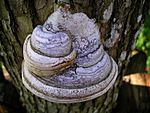Polypore facts for kids
A polypore is a type of mushroom that feels hard and brittle. It has tiny holes, called pores, on the underside of its cap. You often find polypores growing on old, rotted logs and tree stumps. Sometimes, they even grow on living trees!
Some polypores have a stem, and others don't. You might see many caps growing from a single stem. Some polypores can live for so long that moss starts to grow on them.
The name "polypore" comes from Greek. "Poly" means "many," and "pore" means "hole." So, a polypore is literally a "many-pored" mushroom!
Contents
What Are Polypores Like?
The main part of a fungus, called the mycelium, lives hidden in the soil or wood. This is where the polypore mushroom (which is the "fruit body") grows from.
Polypores often grow on specific types of trees. Some prefer deciduous trees (trees that lose their leaves, like oak). Others like conifer trees (trees with needles, like pine). A few types of polypores only grow on one kind of tree! For example, the Piptoporus betulinus polypore only grows on birch trees.
Different Shapes and Sizes
Polypore mushrooms come in many shapes. Some look like typical mushrooms with a cap. Others are thin, flat patches that look like crusts on dead wood.
Some polypores can live for a very long time. For example, a Phellinus igniarius polypore growing on a living tree can be over 80 years old! Most polypores, though, grow new mushrooms every year, or even several times a year. They usually grow the most mushrooms during autumn or the rainy season.
How Polypores Are Built
Polypore mushrooms have a simple structure. Flat, crust-like polypores usually have two layers. The bottom layer is made of tubes that open downwards. The top layer, called the subiculum, supports these tubes and attaches the mushroom to the wood.
If a polypore has a cap, the tissue between the top surface and the pore layer is called the context. A few types of polypores, like Fomes fomentarius, also have a hard core between the context and the tree. Some polypores also have a stalk that holds up the cap. The stalk can be in the middle or on the side, depending on the species.
The Amazing Tubes and Pores
The tubes of a polypore look like a honeycomb. Each tube is fused together. The inside walls of these tubes are covered with a special surface called the hymenium. This is where the mushroom's spores are made. The tubes help protect the developing spores and give the mushroom more space to produce them.
The size and shape of the pores are different for each type of polypore. Some Hexagonia species have very large pores, about 5 millimeters wide. But the pores of Antrodiella species are so tiny you can't see them without a magnifying glass – there can be 15 pores in just one millimeter! Generally, the bigger the pores, the bigger the spores.
A few polypores can make spores in other ways. Some produce special asexual spores on the top surface of their cap. Others make these spores without even growing a full mushroom.
Images for kids
-
Trametes versicolor, a colorful bracket fungus, commonly known as turkey tail
See also
 In Spanish: Polypore para niños
In Spanish: Polypore para niños











